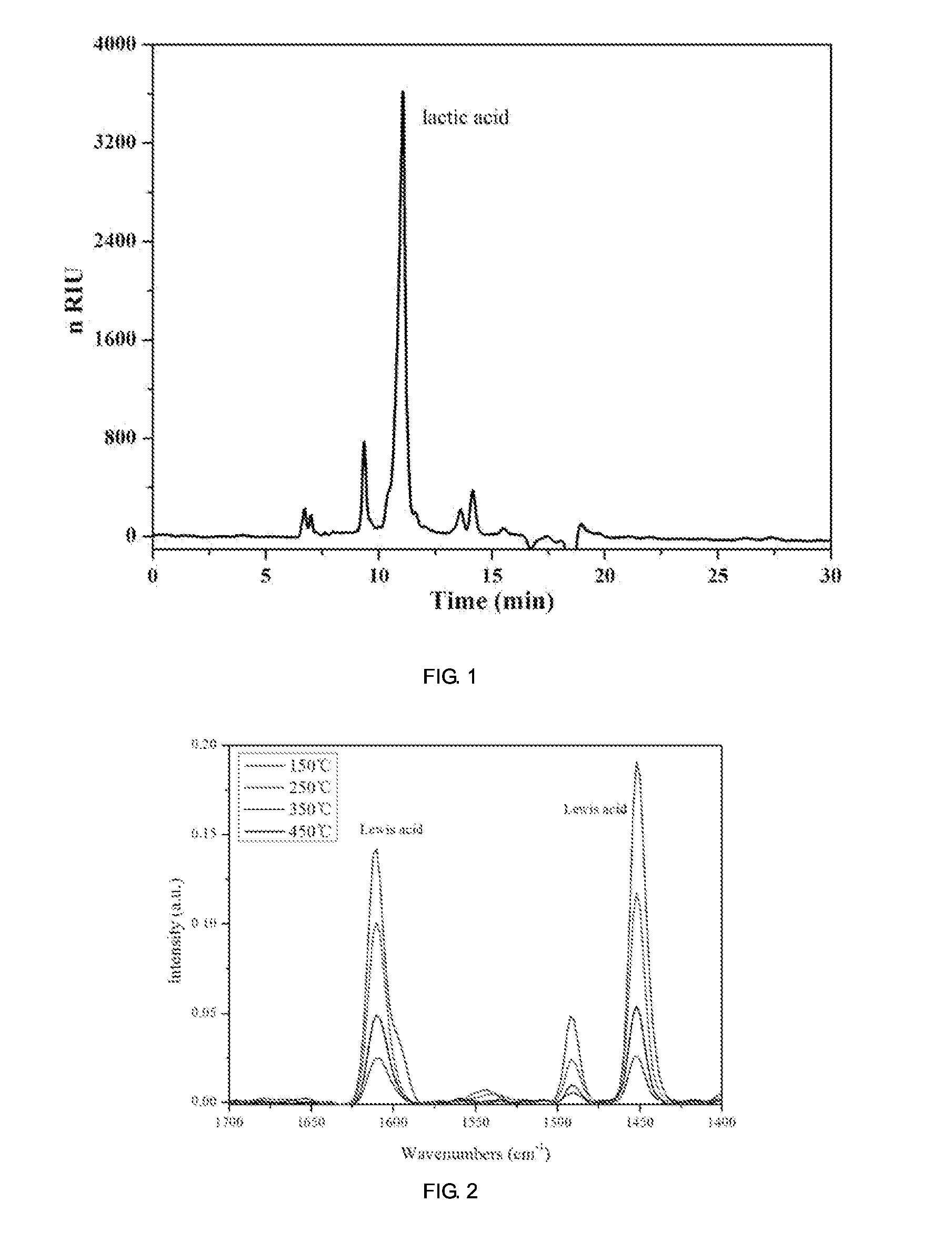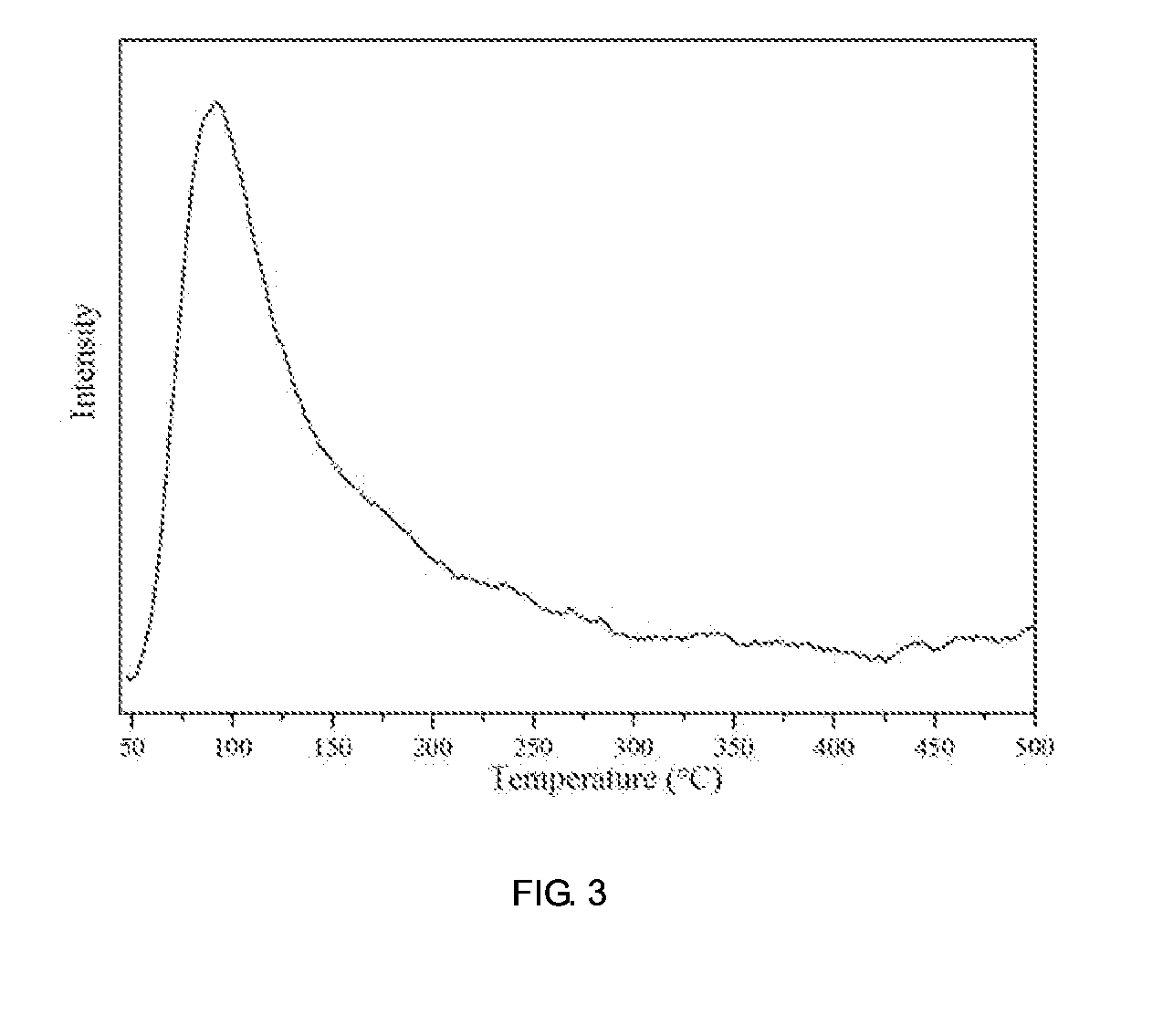Method of transforming biomass into lactic acid with modified beta zeolites
a technology of beta zeolites and biomass, applied in the field of lactic acid, can solve the problems of large gap in lactic acid production worldwide, high strength of artificial limbs, and low probability of inflammation and infection when applied to human bodies
- Summary
- Abstract
- Description
- Claims
- Application Information
AI Technical Summary
Benefits of technology
Problems solved by technology
Method used
Image
Examples
example 1
[0031]Catalyst preparation: The beta zeolites are first mixed with a concentrated nitric acid solution with a mass ratio of 1:110 and stirred at 100° C. for 20 h. Then the mixture is centrifuged and washed for 8 times and dried at 80° C. for 2 h and 150° C. for 10 h to obtain dealuminated beta zeolites. 1 g of the dealuminated beta zeolites is mixed with 83.85 mg of cupric acetate (0.42 mmol Cu) and the mixture is grinded for 15 min and calcined in air at 550° C. for 6 h to obtain dealuminated Cu-beta zeolite catalyst.
[0032]Catalytic reaction: The catalytic reaction is carried out in a Teflon-lined stainless steel autoclave. The autoclave is charged with 225 mg of glucose, 160 mg of dealuminated Cu-beta zeolite catalyst, and 10 g of deionized water. The autoclave is placed in a rotary oven at 190° C. for 2 h with a rotate rate of 20 r / min. After centrifugation at 2000 r / min for 5 min, the remaining liquid is analyzed with High Performance Liquid Chromatography (HPLC). The yield of l...
example 2
[0033]Catalyst preparation: The beta zeolites are first mixed with a concentrated nitric acid solution with a mass ratio of 1:110 and stirred at 100° C. for 20 h. Then the mixture is centrifuged and washed for 8 times and dried at 80° C. for 2 h and 150° C. for 10 h to obtain dealuminated beta zeolites. 1 g of the dealuminated beta zeolites is mixed with 92.19 mg of zinc acetate (0.42 mmol Zn) and the mixture is grinded for 20 min and calcined in air at 550° C. for 6 h to obtain dealuminated Zn-beta zeolite catalyst.
[0034]Catalytic reaction: The catalytic reaction is carried out in a Teflon-lined stainless steel autoclave. The autoclave is charged with 225 mg of sucrose, 160 mg of dealuminated Zn-beta zeolite catalyst, and 10 g of deionized water. The autoclave is placed in a rotary oven at 190° C. for 2 h with a rotate rate of 20 r / min. After centrifugation at 1000 r / min for 20 min, the remaining liquid is analyzed with HPLC. The yield of lactic acid turns out to be 25.5%.
example 3
[0035]Catalyst preparation: The beta zeolites are first mixed with a concentrated nitric acid solution with a mass ratio of 1:110 and stirred at 100° C. for 20 h. Then the mixture is centrifuged and washed for 8 times and dried at 80° C. for 2 h and 150° C. for 10 h to obtain dealuminated beta zeolites. 1 g of the dealuminated beta zeolites is mixed with 99.46 mg of tin acetate (0.42 mmol Sn) and the mixture is grinded for 20 min and calcined in air at 550° C. for 6 h to obtain dealuminated Sn-beta zeolite catalyst.
[0036]Catalytic reaction: The catalytic reaction is carried out in a Teflon-lined stainless steel autoclave. The autoclave is charged with 225 mg of sucrose, 160 mg of dealuminated Sn-beta zeolite catalyst, and 10 g of deionized water. The autoclave is placed in a rotary oven at 190° C. for 2 h with a rotate rate of 20 r / min. After centrifugation at 2000 r / min for 5 min, the remaining liquid is analyzed with High HPLC. The yield of lactic acid turns out to be 26.7%.
PUM
 Login to View More
Login to View More Abstract
Description
Claims
Application Information
 Login to View More
Login to View More - R&D
- Intellectual Property
- Life Sciences
- Materials
- Tech Scout
- Unparalleled Data Quality
- Higher Quality Content
- 60% Fewer Hallucinations
Browse by: Latest US Patents, China's latest patents, Technical Efficacy Thesaurus, Application Domain, Technology Topic, Popular Technical Reports.
© 2025 PatSnap. All rights reserved.Legal|Privacy policy|Modern Slavery Act Transparency Statement|Sitemap|About US| Contact US: help@patsnap.com


